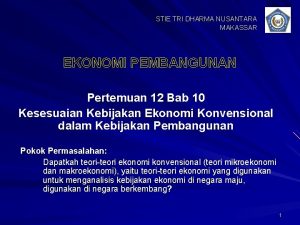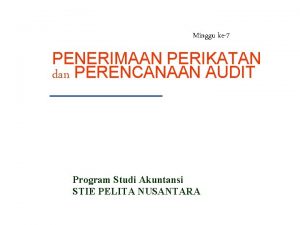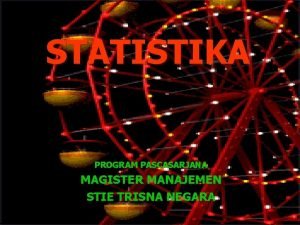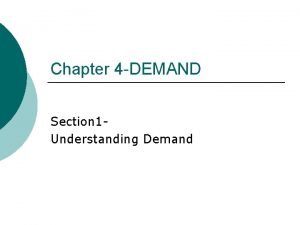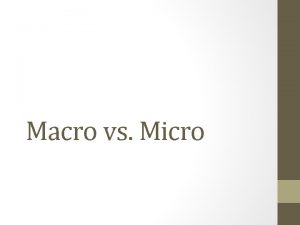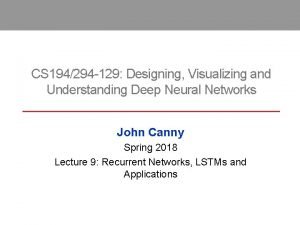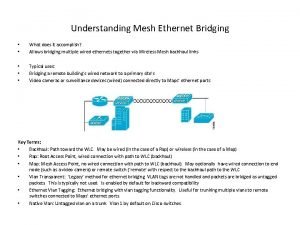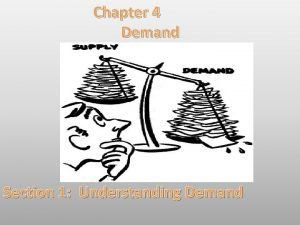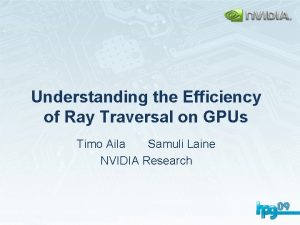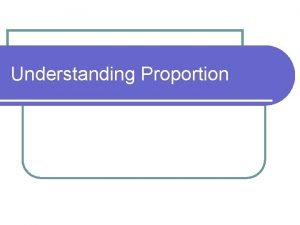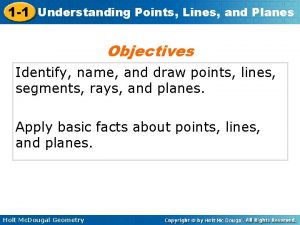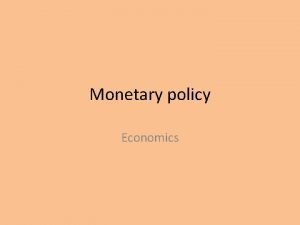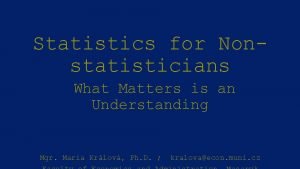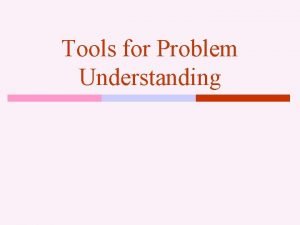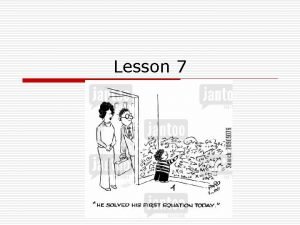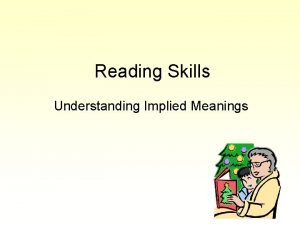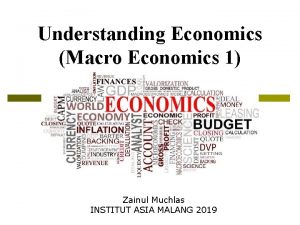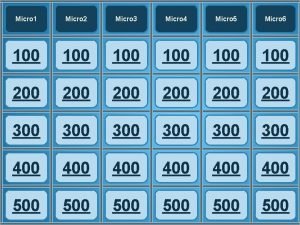Understanding Economics Micro Economics 3 Zainul Muchlas STIE










































































- Slides: 74

Understanding Economics (Micro Economics 3) Zainul Muchlas STIE ASIA MALANG

MONOPOLY

What we will learn… Sources of Monopolies p Production and Pricing Decision of a Monopolist p The Welfare Cost of Monopoly p Public Policy toward Monopolies p Price Discrimination p

Examples of Monopolies

Definition A firm that is the sole seller of a product without close substitutes. Key features : 1. One Seller & Many Buyers 2. Seller is Price Maker, whereas Buyers are Price Takers. 3. No Close Substitutes 4. Existence of Barriers of Entry Such as : Legal or Technological or Geographical Barrier.

Monopoly vs. Competitive Markets The key differences are : 1. The Nature of The Products No Substitutes vs. Homogeneous Products 2. Market Power vs. No Market Power

Sources of Monopolies p Resource-Based p Government-Created p Patent & Copyright Laws p Technological or Natural

Resource-Based Monopolist Occurs as a result of exclusive ownership of the essential production resources. Ex. : If the only petrol station in the city is owned by you, then you are petrol monopolist in the city.

Government-Created Monopolist Occurs as a result of the exclusive rights to operate in a specific market granted to a specific firm. Often it is granted on the basis of economic efficiency or political pressures. Ex : Kings in the Ancient Times, Firms which have good relationship with the Government.

Patent & Copyrights Law Occurs as a result of government action to grant exclusive rights, to inventors and authors to their respective inventions and creations. This is important legal structure which will encourage innovation. Ex : Medical Drugs, Technologies, Books.

Technological or Natural Monopolist Occurs because a single firm can supply the market at a lower average cost compared to other firms. Reason : Economics of Scale Classical Example : Public Utilities (Gas & Electricity). Cost ATC Output

Production and Pricing Decisions of a Monopolist p Demand Curve p Monopolist’s Revenue p Profit Maximization Decision p Calculating Monopolist’s Profit

Demand Curve (1) A competitive firm is price taker, therefore the demand curve is horizontal (No Market Power). In competitive markets, firms could simply increase output, without altering the market price. P = MR = AR. P Demand Q

Demand Curve (2) Monopolist is price maker, therefore the demand curve is downward sloping (Market Power). P Demand Q

Monopolist’s Revenue (1) Q 0 1 2 P 4. 5 4 3. 5 TR 0 4 7 3 4 5 6 7 8 3 2. 5 2 1. 5 1 0. 5 9 10 10 9 7 4 MR +4 +3 +2 +1 +0 -1 -2 -3

Monopolist’s Revenue (2) P MR Demand Q

Monopolist’s Revenue (3) p MRCompetitive Firm ≠ MR p For Monopolist MR < P. When a monopolist wants to sell more output, it has to lower its price. p p Monopolist Two effects : 1. The Output Effect : Q is higher, raises revenue. 2. The Price Effect : P is lower, reduces revenue.

Monopolist’s Revenue (4) Let the monopolist has the following demand function, p P = -AQ + B p TR = P x Q = -AQ 2 + BQ MR? p Taking a first derivative of TR, you get MR. p

Monopolist’s Revenue (5) TR = P x Q = -AQ 2 + BQ p MR = -2 AQ + B p P = -AQ + B p P, MR B MR Demand B/2 A B/A Q

Basic Rules : Differentiation For any function f(x), g(x), h(x), with real number a and real number b. p p If f(x) = ax, then f’(x) = a. If f(x) = xb, then f’(x) = bxb-1. If f(x) = axb, then f’(x) = abxb-1. If h(x) = f(x) + g(x), then h’(x) = f’(x) + g’(x).

Profit Maximization Decision (1) p Monopolist maximizes its profit by producing at quantity where MR = MC. How does it decide the price then? p Decide the price from the Demand Curve. p

Profit Maximization Decision (2) P MC PMonopolist MR QMonopolist Demand Q

Profit Maximization Decision (3) P MC PMonopolist ATC PROFIT MR QMonopolist Demand Q

Market Power of a Monopolist In competitive markets, P = MR = MC. p But in monopoly markets, P > MR = MC. p In monopoly markets, monopolists have the market power. p Market power refers to the ability to influence price. p

Where is the Supply Curve? p Monopolist does not have a Supply Curve, because : Price Maker. Q does not depend on P. Q & P are jointly determined by MC, MR, and Demand Curve. p Competitive Firm Price Taker. Q depends on P.

Case Study : Monopoly Drugs vs. Generic Drugs (1) P Pwith patent PROFIT MC = ATC Pafter patent expires MR QMonopolist Demand Q

Case Study : Monopoly Drugs vs. Generic Drugs (2) p Marginal Cost of Most Drugs Production is roughly constant. p In Practice : Our analysis holds. During the patent period, P > MC. After the patent expires, more firms are coming with generic drugs (identical chemical contents), and drives the price down. Nevertheless, monopolist does not lose all its market power, due to the existence of loyal customers.

The Welfare Cost of Monopoly (1) p Recall : In Competitive Markets, P=MC and Total Surplus is Maximized. P MC (Supply) CS P=MR PS Demand Q

The Welfare Cost of Monopoly (2) p Recall : In Monopoly Markets, P>MC and Total Surplus is NOT Maximized. P MC (Supply) DWL MR Demand Q

Who always suffer in Monopoly Markets? Markets p Consumers have no choice, but to buy from the monopolist. p Monopolist could charge the consumers at P>MC.

Public Policy Toward Monopolies p Antitrust Laws p Regulation p Public Ownership p Doing Nothing

Antitrust Laws (1) Antitrust Laws to limit monopoly power and make the markets more competitive. Pioneer of Competition Policies : The United States. Ex : Sherman Antitrust Act (1890), Clayton Act (1914).

Antitrust Laws (2) Practices that can limit competition : 1. Predatory Pricing Practice of Pricing which its main purpose is to drive current competitors out of business and to discourage new entrants. 2. Mergers and Acquisitions (M&A)

Antitrust Laws (3) Antitrust Laws influence firm behavior in two ways : 1. Conduct Remedy Refers to Business Practices. 2. Structural Remedy Refers to Change in Market Structures.

Antitrust Laws (4) Antitrust Laws have benefits, but it also have its costs. Possible Costs : ‘Catch person with the good motives’. Critics of antitrust laws are skeptical on the government’s ability to perform costbenefit analysis with sufficient accuracy.

Regulation (1) Marginal Cost Pricing Requiring firms to set its price to be equal to MC. Complication for Natural Monopolist : 1. Natural Monopolist has falling ATC for all Q. 2. Thus MC < ATC. 3. Monopolist makes losses. Possible Imperfect Solution : Subsidy the Monopolist. It also has costs to the society as a whole (deadweight loss).

Regulation (2) Average Cost Pricing Requiring firms to set its price to be equal to ATC. Complication : Zero Economic Profit. It might discourage monopolists to find technologies which might reduce costs.

Public Ownership Government takes charge of natural monopolist’s business. Ex : Public Utilities. p Economists prefer private ownership to public ownership of natural monopolies. Ownership matters, it affects the production costs. Private Owners have incentive to cut costs, if it could increase profit. Government Officials may become a special-interest group and try to block cost-reducing reforms.

Doing Nothing George Stigler (Nobel Prize in Economics Recipient – 1982) “A famous theorem in economics states that a competitive enterprise economy will produce the largest possible income from a given stock of resources. No real economy meets the exact conditions of theorem, and all real economies will fall short of the ideal economy—a difference called “market failure. ” In my view, however, the degree of “market failure” for the American economy is much smaller than the “political failure” arising from the imperfections of economic policies found in real political systems”.

Price Discrimination (1) The business practice of selling the same good at different prices to different customers. Discrimination might based on age, gender, occupations, etc. What is the purpose? Profit Maximization

Price Discrimination (2) Four necessary conditions for price discrimination to lead to an increase in profit : 1. The firm must be Price Maker. 2. The firm must be able to identify Willingness-To-Pay (WTP)correctly. 3. The firm must be able to prevent arbitrage activity. 4. Transaction Costs < Benefits.

Price Discrimination (3) Two schemes of price discrimination : 1. Perfect Price Discrimination Charge every customer at P = WTP. 2. Imperfect Price Discrimination Segment the market price.

Price Discrimination (4) Single Price vs. Perfect Price Discrimination P P CS PROFIT DWL MC MR D Q MC D Q

Price Discrimination (5) p The purpose of price discrimination is to maximize profit. p In the language of economics welfare, producer wants to maximize its surplus by transforming every part of consumer surplus into producer surplus.

Imperfect Price Discrimination In the real world, It is impossible to know perfectly the WTP of every buyers. Therefore, monopolist could discriminate price using other factors, such as age, gender, occupation.

Examples of Price Discrimination p Movie Tickets p Airline Prices p Financial Aid p Quantity Discounts

Final Remarks In real world, pure monopoly is rare. p Nevertheless, many firms have certain market power, such as unique product, large market share, few significant competitors. p p In most cases of firms with market power, there exists losses shown in deadweight loss, and mark-up price (P>MC).

MONOPOLISTIC COMPETITION

What we will learn… The Similarity between Monopolistic Competition and Perfect Competition. p The Similarity between Monopolistic Competition and Monopoly. p Price-Quantity Decision Criteria p Monopolistic Competition and Social Welfare p Social Costs and Benefits of Advertising p

Definition Market structure in which many firms sell similar products, but not identical. Examples : p Books p Clothing p Fast Food p Apartments

Perfect Competition vs. Monopolistic Competition Perfect Competition Monopolistic Competition Many Free Entry/Exit Yes Long-Run Economic Profits Zero Nature of Products Homogeneous (Identical) Differentiated No Yes Horizontal Downward Sloping Number of Sellers Market Power Firm’s Demand Curve

Monopoly vs. Monopolistic Competition Monopoly Monopolistic Competition One Many No Yes Long-Run Economic Profits Positive Zero Nature of Products No Substitutes Differentiated Yes Downward Sloping Number of Sellers Free Entry/Exit Market Power Firm’s Demand Curve

Price-Quantity Decision Criteria p Profit Maximization or Loss Minimizing, Q when MC = MR. p Relevant price is reflected on the Demand Curve.

Monopolistically Competitive Firms in the Short Run (1) P, Costs MC P ATC PROFIT ATC MR Q Profit-Maximizing Demand Q

Monopolistically Competitive Firms in the Short Run (2) P, Costs MC ATC P LOSS MR Q Loss Minimizing Demand Q

The Long-Run Equilibrium (1) p The Long-Run Equilibrium follows the same reasoning as its of competitive markets. p If there is profit opportunity, new firms will enter. If there is no profit opportunity, no firms will enter. If firms are making losses, some firms will leave the market. p p p The entry-exit dynamics will stop only when firms are making zero economic profits (P = ATC).

The Long-Run Equilibrium (2) p Entries of new firms will cause a fall in demand for the existing firms. p Exits of some existing firms will cause an increase in demand for remaining firms.

The Long-Run Equilibrium (3) P, Costs MC ATC P = ATC Mark-Up MC MR Q Profit-Maximizing Demand Q

The Long-Run Equilibrium (4) Two Characteristics : 1. Like in Monopoly Markets, P > MC. 2. Like in Competitive Markets, P = ATC (with zero economic profit), but not at the minimum ATC.

Monopolistic Competition is Less Efficient than Perfect Competition (1) Excess Capacity Monopolistic Firms do not produce at Q where… P = Minimum ATC. It means, they do not produce at efficient scale.

Monopolistic Competition is Less Efficient than Perfect Competition (2) Mark-Up Price Monopolistic Firms charge P > MC. Competitive Firms charge P = MC.

Monopolistic Competition and Welfare (1) p Do not maximize the welfare in the society. p P > MC. p Q < Socially Efficient Quantity. p Can it be fixed? It might be difficult, as firms earn zero economic profits.

Monopolistic Competition and Welfare (2) p Number of Firms might not be ‘ideal’ (too much or too little). p Entry of new firms have two effects : Product-Variety Externality (Positive to Consumers) Business-Stealing Externality (Negative to Producers) 1. 2. p However, in practice, it is difficult to measure accurately.

Monopolistic Competition and Welfare (3) Too Many Firms in The Long-Run Too Few Firms in The Long-Run $ $ Total Surplus Profit Number of Firms N in the Long-Run

Monopolistic Competition and Welfare (4) In conclusion : 1. Invisible Hands in Monopolistically Competitive Markets are not maximizing Total Surplus. 2. There is no easy way for public policy to improve the market outcome (due to its subtle causes).

Advertising (1)

Advertising (2) p In Monopolistic Competitive Markets, it is natural to use advertisements to get customers, due to its differentiated nature of the products. p Economists disagree about the social value of advertising activities.

Critique of Advertising p Wasting Resources. p Manipulating People’s Preferences. p Impedes Competition by creating false perceptions that the advertised products are really different from the competitors, and thus it will allow the firm to further mark the price up.

Defense of Advertising Provides Useful Information to Consumers. p Informed Consumers could exploit price differences. p Promotes Competition & Reduces Market Power. p A study on advertising and price of eyeglasses shows that advertising activities reduces the price level of eyeglasses.

Advertising as a Signal of Quality p Companies which are willing to spend so much money on advertising make consumers think that the product must be good. p Advertisements will attract new consumers to buy at least once. To ensure that consumers are coming back, the companies must ensure that their products are of high quality.

Brand Names are everywhere. p Firms which have Brand Names tend to spend more money on advertisements, and thus usually charge higher prices for their products. p p Again, Economists disagree on the social value of Brand Names.

Critique of Brand Names p Cause consumers to perceive differences that do not really exist. p Consumer’s Willingness to Pay tend to be Irrational. p Increases general price levels.

Defense of Brand Names provide information about the quality of the products to consumers. p Companies with brand names will have the incentive to maintain the product quality, in order to protect their reputation.

 Zainul abedin paragraph
Zainul abedin paragraph Zainul abideen 4
Zainul abideen 4 Dua imam zain ul abideen
Dua imam zain ul abideen Sukur ali khan
Sukur ali khan Sabina abedin
Sabina abedin Imam zain ul abideen dua
Imam zain ul abideen dua Doc zainul abidin hamid
Doc zainul abidin hamid Stie pasundan
Stie pasundan Stie muhammadiyah
Stie muhammadiyah S2 pertiba pangkalpinang
S2 pertiba pangkalpinang Stie tri dharma nusantara makassar
Stie tri dharma nusantara makassar Stie cirebon
Stie cirebon Sunt un mesager
Sunt un mesager Rumus garis anggaran
Rumus garis anggaran Stie cirebon
Stie cirebon Aspek pasar dan pemasaran
Aspek pasar dan pemasaran Stie dewantara cibinong
Stie dewantara cibinong La zidirea soarelui se stie
La zidirea soarelui se stie Stie pelita nusantara
Stie pelita nusantara Biaya kuliah di stie trisna negara
Biaya kuliah di stie trisna negara Contoh etika deskriptif dalam kehidupan sehari-hari
Contoh etika deskriptif dalam kehidupan sehari-hari Economics chapter 4 section 1 understanding demand answers
Economics chapter 4 section 1 understanding demand answers Define macroeconomics
Define macroeconomics Micro and macro economics venn diagram
Micro and macro economics venn diagram Definition of macroeconomics
Definition of macroeconomics School of business and economics maastricht
School of business and economics maastricht Mathematical economics vs non mathematical economics
Mathematical economics vs non mathematical economics Adler and rodman 2006
Adler and rodman 2006 Cs 231 n
Cs 231 n Vdoe understanding scoring
Vdoe understanding scoring Understanding the act
Understanding the act Understanding ekgs a practical approach
Understanding ekgs a practical approach Understanding four and five year olds
Understanding four and five year olds Chapter 1 lesson 2 what affects your health
Chapter 1 lesson 2 what affects your health Let's get connected song
Let's get connected song Understanding business communication
Understanding business communication Cisco mesh ethernet bridging
Cisco mesh ethernet bridging Understanding the scriptures chapter 5 study questions
Understanding the scriptures chapter 5 study questions Lesson 1 understanding demand
Lesson 1 understanding demand Understanding earth 7th edition
Understanding earth 7th edition Understanding science lesson 1 answer key
Understanding science lesson 1 answer key Understanding the efficiency of ray traversal on gpus
Understanding the efficiency of ray traversal on gpus Understanding ratio
Understanding ratio Understanding qualitative research
Understanding qualitative research Enduring understanding examples
Enduring understanding examples National 5 pe marking scheme
National 5 pe marking scheme Module 22 understanding consciousness and hypnosis
Module 22 understanding consciousness and hypnosis What is real self means
What is real self means Title v air permits 101
Title v air permits 101 Understanding points lines and planes
Understanding points lines and planes National 5 understanding standards
National 5 understanding standards Structures higher business
Structures higher business Understanding student differences
Understanding student differences Global understanding examples
Global understanding examples Understanding inflation
Understanding inflation Understanding groups and teams
Understanding groups and teams Understanding statistics
Understanding statistics Financial algebra 3-1 checking accounts worksheet answers
Financial algebra 3-1 checking accounts worksheet answers Hipp sentence starters
Hipp sentence starters Synoptic charts geography
Synoptic charts geography The understanding group
The understanding group Contoh critical incident
Contoh critical incident Ways of enriching the bible understanding
Ways of enriching the bible understanding Understanding your business finances
Understanding your business finances Lesson 7 understanding equations
Lesson 7 understanding equations Understanding implied meaning
Understanding implied meaning In my understanding
In my understanding Understanding hospice
Understanding hospice Types of operating system
Types of operating system Conscious marketing definition
Conscious marketing definition All learning is understanding relationships
All learning is understanding relationships Semantic understanding
Semantic understanding Understanding behaviour responding safely
Understanding behaviour responding safely Understanding modbus
Understanding modbus Understanding chemical reactions worksheet answer key
Understanding chemical reactions worksheet answer key










